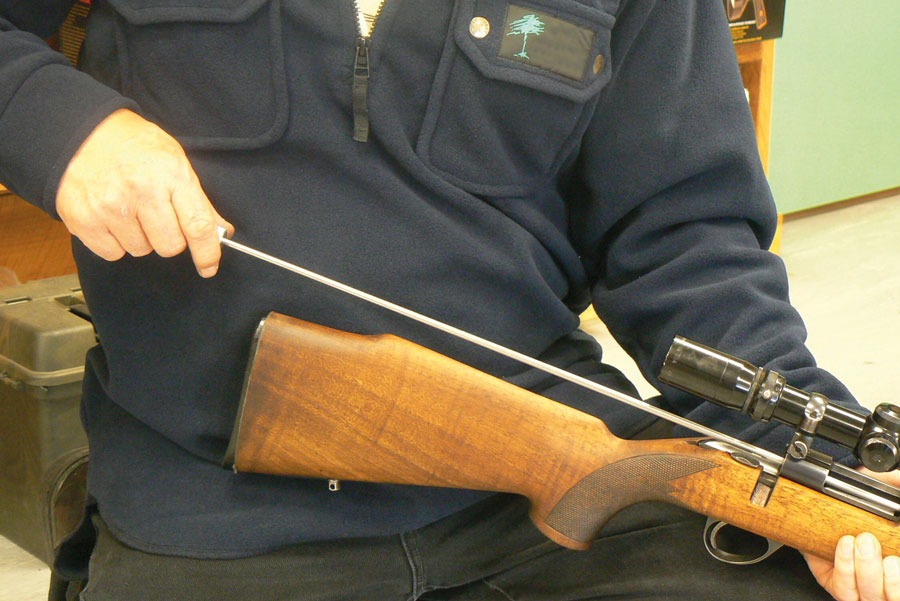Firearms Safety
Handling your firearm safely
Cleaning firearms
Firearms are made of metal and wood or composite material. Regular cleaning and maintenance will keep your firearm safe and reliable.
It is essential that the barrel is free from obstruction.
Before storing your firearm you should clean the barrel with a rod, clean patches and solvent. Where possible, insert the cleaning rod from the chamber end of the bore to avoid damaging the muzzle.
When you have cleaned the barrel push an oily patch through it. Clean the action and the outside of the firearm. Wipe all metal parts with a lightly oiled rag.
When you are taking your firearm out for use, point it in a safe direction then check that it is not loaded. Push a clean patch through the bore and check that the barrel and action are clean and dry. Grease or oil in the action can cause a misfire. If either gets into the barrel, they can cause it to bulge or burst.

When hunting, take cleaning gear with you – at least a pullthrough, patches and oil. At the end of each day clean and oil the barrel.
Cleaning a firearm. The rod is inserted from the chamber end of the barrel.
If you have any doubts about a safety catch – take it to a gunsmith!
Correct ammunition
It is important to use the correct ammunition for your firearm. Even if you have the right calibre, it may not necessarily be the right ammunition. The chambering may be unsuitable or the action may not be strong enough e.g. .22 short, .22 long, .22 long rifle and .22 magnum are all .22 rimfire, yet are not suitable for every .22 rimfire rifle.
If the wrong ammunition is chambered it may be too big to allow the action to close. If it is too small it can slip so deeply into the chamber that it is out of reach of the firing pin. Worse still, it may fit, allow the action to close and fire the wrong calibre bullet. This could burst the barrel or
cause a dangerous blowback of gas in the shooter’s face.
Numbers that show the calibre are stamped on the base of the cartridge case. However, sometimes there are other numbers or words to identify one cartridge from another. You should know the correct and full description of the cartridges your firearm requires. To make sure there is no mistake, use that description when ordering ammunition, and also check the description on the ammunition packet.
Many shooters reload their own cartridges because of economy and accuracy. Brass cartridge cases are sometimes pressed through resizing dies to become a type different from the original e.g. a 30.06 Springfield case may become a .270 cartridge. So, the information stamped on the base of the case can be misleading. A new shooter would be wise to use only factory-made ammunition purchased from a shop.
Do not use old or corroded ammunition. It can cause misfires, burst cases and block the barrel. Wet or damp ammunition can increase pressure in the firearm and could also damage and injure. Never attempt to dry wet ammunition by heating it.
Crossing/climbing fences
If there is a gate – use it! Never climb a fence while carrying a firearm. Carrying loaded firearms through fences and over obstacles can result in injury and death.
Crossing/climbing fences must be done carefully.
- If there are two or more people, one should climb over the fence without a firearm. Then, pass the unloaded firearms across with the actions open, and pointed in a safe direction.
- If you are on your own, unload the firearm and place it, muzzle first, through the fence. Lay the firearm on the ground, and then climb over the fence.
- Take special care when crossing electric fences. Have your firearm unloaded and the action open before you get near an electric fence. An electric shock can cause your muscles to contract and your hands to clench.
When hunting
Half-open bolt or action in a state of semi-readiness (Shotguns and rifles except self loading)
The state of ‘semi-readiness’ can be taken up prior to taking a shot. Hold the firearm in both hands, with a cartridge pushed partly forward into the chamber.
Do not close the action completely unless you know you have correctly identified your target and you have time to make a safe shot. If you do close the action but then do not take a shot, go back to the ‘semi-ready’ state with a half – open action.
A ‘break open’ shotgun can be carried in the hinged open position with cartridges in the chambers. This is semi-ready with a shotgun. The firearm is safe while open and can beclosed and fired quickly and easily.
The semi-ready condition with half- open bolt is not always practical. Unless the bolt is held with the thumb, it may slide backwards and eject the round completely. In this case, the bolt is best left closed on an empty chamber. When you have reached the shooting area and you are ready to take a shot, only then should a round be fully loaded into the chamber and the bolt fully closed.

